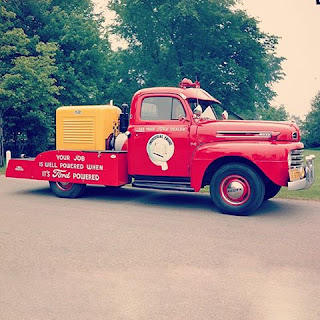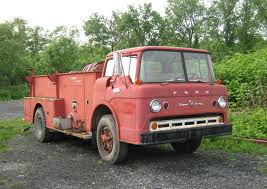The
1972 Ford Carousel minivan concept car just barely missed a chance
steal a beat on Chrysler and tap a large latent market for family
haulers.
Chrysler Corporation likes to boast that its 1984 Dodge
Caravan/Plymouth Voyager pioneered the minivan concept, but that's only
true of front-wheel-drive designs. The real originator was Volkswagen,
which had sold rear-drive minivans since the early 1950s in the
Beetle-based Type 2 Microbus (through 1979) and the later Vanagon.
There
was also Chevrolet, which had imitated VW for 1961 with a trio of
trucks derived from its compact Corvair, another air-cooled rear-engine
car. Besides a novel pickup called Rampside, Chevy offered Corvan
commercial and Greenbrier passenger vans remarkably similar in size and
shape to the Chrysler models of nearly a quarter-century later.
That
same year, 1961, Ford trotted out a group of Falcon-based compact
trucks called Econoline: initially a pickup, commercial van, and
windowed passenger van. All had conventional rear drive and boxy
"cab-over-engine" bodywork like the VW's and Chevy's, but hewed to
orthodoxy with water-cooled six-cylinder engines mounted in front.
Simple
and reliable, Econoline sold well from the first, easily outpacing the
more trouble-prone Corvan/Greenbrier. It also outlasted them in the
marketplace. Almost predictably, though, Econoline grew quite a bit
larger when first redesigned for 1968.
Then again, the truck
market itself was growing -- and subdividing, just as automotive classes
had done with compacts, intermediates, and personal-luxury models. When
buyers began clamoring for utility vehicles in the image of the wartime
Jeep, Ford obliged them with the Bronco for 1966.
Meanwhile,
custom vans had become the rage with many younger people of the "hippie"
stripe, and commercial users were demanding bigger, heftier vans as
well as pickups. That set Ford to working on an even larger Econoline.
Developed as project "Nantucket," this third-generation design was
pretty much locked up by 1972. Introduction was slated for model-year
1975.
But something else was afoot, or so thought one Lido Anthony
Iacocca, the former super-salesman from Pennsylvania who had fast
climbed the ladder at Ford Motor Company to become its president in
1970.
That presidency was partly his reward for "fathering" the
original Mustang ponycar and some newer Dearborn winners. Of course,
Iacocca wasn't solely responsible for the Mustang's huge success, as he
(and others) liked to claim, but he could spot emerging market trends.
1972 Ford Carousel Minivan Concept Car Development
Among
Lee Iacocca's first tasks after he took over as Ford president in 1970
was the 1972 Ford Carousel minivan concept car development program.
With vans bigger than ever, in popularity as well as size, Iacocca began
wondering whether there might be a market for something smaller and
less "trucky" -- in other words, a more maneuverable "carlike" van.
Suitably
priced, it could have great appeal to "vannies" and smaller families
for camping and other recreational uses, as well as a light-duty urban
commercial. For some buyers, this "minivan" might even be a roomier,
more versatile alternative to the traditional station wagon.
Accordingly,
Iacocca approved development of what came to be called the Carousel.
Conceived as a more compact "garageable van," it was planned around
dimensions that harked back to the first Econoline, plus, at first, an
all-new drivetrain.
But cost concerns soon prompted changing the
concept to essentially a cut-down version of the just-completed
Nantucket, with most of its innards but different outer sheetmetal and
more carlike amenities.
The revised approach offered benefits
apart from reducing development time and tooling costs, not to mention
retail price. Cutting down Nantucket's inner body and ladder-type frame
promised a very strong, rigid platform; the separate chassis, combined
with a heavily insulated floorpan and thick bushings beneath driveline
and body, promised a quiet vehicle without the unpleasant rough-road
"drumming" that marred so many unit-construction cars.
Of course,
front-wheel drive never figured in the equation. At the time, the
configuration was not yet fashionable for Detroit cars, let alone
trucks. Even today it's sometimes deemed undesirable compared to
rear-drive because it tends to limit towing ability, an important
consideration for many truck buyers. That benefit helps underpin the
demand for sport-utility vehicles based on rear-drive truck chassis.
1972 Ford Carousel Minivan Concept Car Styling
Ford
designer Dick Nesbitt was chiefly responsible for 1972 Ford Carousel
minivan concept car styling. Nesbitt was also a principal in shaping the
1974 Ford Mustang II.
Striving to avoid the "school bus look"
typical of contemporary big vans, he penned a glassy roofline not unlike
that of Chevy's classic mid-1950s Nomad wagon, with slanted B-posts,
thin C-pillars, and three windows per side: one for each front door and
two behind. The rearmost panes curved slightly around the back to meet
modest D-posts, matched by wrapped, tri-color vertical taillamps.
Ribbed
appliqués in a dark charcoal color adorned lower body and tailgate to
respectively lower and widen appearance, though they would have been
omitted on the woody-look "Squire" version that Ford marketers wanted.
The tailgate itself was a drop-down wagon-style affair with retracting
window.
Some Carousel sketches furthered the Nomad look with a
slight roof-panel "step-down" behind the B-posts; etched with slim
longitudinal lines, it was the natural spot for an optional luggage
rack.
Up-front ideas involved variations on Ford's then-favored "power
dome" hood theme, with four round headlights in separate square bezels
astride big, mostly rectangular grilles.
Like Nantucket but not
earlier Econolines, the Carousel had a definite, if stubby nose. This
allowed the engine to sit farther forward, which opened up extra space
and lessened noise inside.
Ford president Lee Iacocca, who
spearheaded the Carousel effort, also wanted the protruding front
sheetmetal as a "crumple zone" for absorbing energy in collisions -- a
sales plus for the safety-minded (including, one presumes, the likes of
Ralph Nader).
As
was becoming de rigeur for vans, a sliding right-rear door provided
access to Carousel's rear compartment, for which there was no shortage
of ideas. Nesbitt later recalled that one of the more striking proposals
was a U-shaped "lounge" formed by a rear-facing bench behind the front
cabin and an inward-facing bench along each side wall. Individual
"captain's chairs" seated driver and front passenger.
After weeks
of what Nesbitt described as "frantic effort," the Carousel was ready
for management review in November 1972: a full-size clay with
Squire-type side trim and conventional front-facing second and third
bench seats. Iacocca, product-planning whiz Hal Sperlich, and even
chairman Henry Ford II were all impressed enough to approve construction
of a running metal-bodied prototype for production engineering
purposes.
1972 Ford Carousel Minivan Concept Car Aftermath
After
several years of development, Ford planned to launch the Carousel
minivan alongside the new 1975 Econoline full-size van. But it didn't
happen, and the 1972 Ford Carousel minivan concept car aftermath is the
stuff of legends.
When OPEC turned off America's oil tap in late
1973, gas supplies dwindled, prices soared, and people lined up to buy
small economy cars, shunning bigger vehicles as never before -- cars and
trucks alike. With that, Ford decided the Carousel had no future, and
abruptly canceled it.
What happened next is that Lee Iacocca,
fired by Henry Ford II in 1978 from the position of president, took
fellow executive Hal Sperlich along to rescue faltering Chrysler. He
sealed its recovery by reviving the Carousel concept for the T115
Caravan/Voyager, thus uncovering the huge minivan market that Chrysler
still dominates today. Ironically, the T115 was much like what the
Carousel would have been except for being based on a front-drive
passenger car (Chrysler's life-saving 1981 K-body compact).
In
retrospect, then, Ford was unwise to throw out its baby-van idea with
the energy-crisis bathwater. Though RV sales remained sluggish, the
overall market was again healthy when the 1975 Econoline appeared.
Considering
how Chrysler later fared with minivans, it's likely Carousel would have
been another sales blockbuster a la Mustang -- and another big feather
in Iacocca's fedora. While it probably wouldn't have prevented his
firing, it would have given Dearborn a big competitive edge in the
light-truck field for the second energy crisis that hit in 1979.
And
there's the greatest irony of all, for the Carousel promised to be far
more fuel-efficient than any full-size van would be for a long time to
come. Though its likely powertrains remain unclear, lower weight implied
a nice performance/economy balance with a modest six, and better than
adequate performance with Ford's 302-cubic-inch small-block V-8, which
certainly would have fit.
But Dearborn missed its chance to define
the modern minivan and has had to play catch-up ever since -- first
with the trucky rear-drive Aerostar, then the Chrysler-like front-drive
Ford Windstar. By 2006, Ford was out of the minivan business altogether,
and had cast its family-hauler lot with "crossover" wagons such as the
Taurus X and Flex.
If there's a moral to this story, it is that a good idea remains a good idea no matter who takes advantage of it first.
Source: Howstuffworks



































































